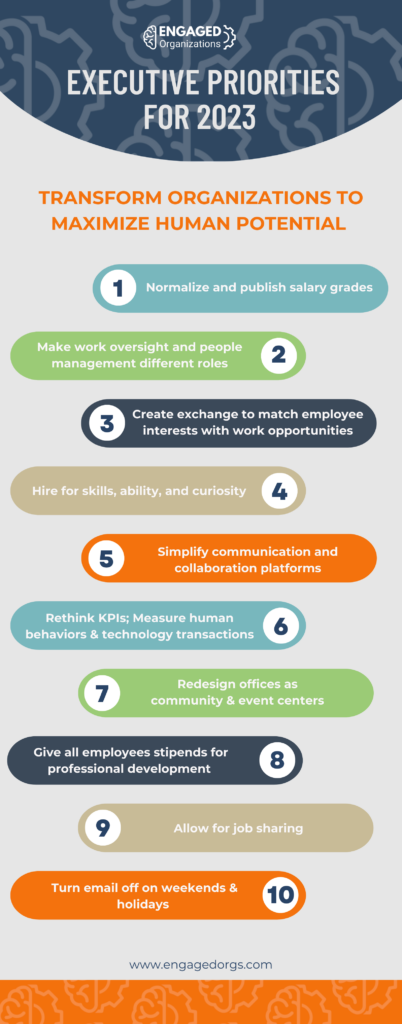Engagement is a hot word right now. But what does it mean?
The answer likely lies in who is using the term, the context, and the orientation. It’s a word that is thrown around a lot. It is rarely clarified, creating the perception of alignment where it does not exist. It’s critical to unpack it because its overuse is creating a lot of confusion, poor results, and stress. Employee engagement is at an all-time low, and while there are obviously a lot of reasons for this, ironically, the focus on and lack of clarity around engagement may be contributing to…. lower engagement.
The Problem with the Word Engagement
I shared my perspective about engagement and some of the challenges in this post; Rethinking Engagement Analytics:
Engagement is a spectrum of psychological intensity and is useful to broadly discuss how active, interested, and committed people are. That vague general definition was all fine… until we started trying to measure engagement.
Rachel Happe
In the organizational context, engagement is used as a catch-all term.
For communications professionals, engagement might mean pageviews and email open rates.
For HR, engagement might mean employee sentiment as collected through surveys.
For managers, engagement is doing work and proactively addressing issues and opportunities.
For IT, engagement is more broadly used because they are tasked with supporting every group within the organization and likely don’t want to mediate what it means.
How Engagement Became So Toxic


IT groups and the vendors with whom they partner, however, have a lot to answer for; by avoiding more precise definitions because they keep adding more and more overlapping engagement platforms without any rationalization. Employees are drowning in channels with no rationalization about what happens where. Digital transformation has made the average employee’s job much worse because engagement, communications, and collaboration functionality has not been streamlined or rationalized. One of the reasons I published Becoming Hybrid: A Team Collaboration Handbook was so that managers and teams – in the absence of organizational rationalization – had some structure to develop shared commitments about where, how, and when they collaborate.
The definitions of engagement and collaboration matter less than a shared understanding of and agreement on how specific work happens. To do this well requires an understanding of technology, operations, business value, and group dynamics. That is a high bar for most managers, many of whom have never had much training in basic management, let alone systems dynamics, strategy, and technology. No wonder employee engagement is going down – employees are being hung out to dry without the support, perspective, and experience needed to make work better.
The C-Suite is Clueless


Calling C-level executives clueless may sound harsh, but when Morgan Stanley’s CEO James Gorman says things like, “They (employees) don’t get to choose their compensation,” you begin to wonder if we have reverted to a system of slavery. Of course, it is not all c-suite executives, but they are so removed from the experience of being an employee – especially an employee who has gone through a global pandemic and is likely juggling a lot of personal demands – that they have no idea how bad it is. CEOs have chiefs-of-staff, secretaries, and dedicated communications professionals; with a staff like that, I wouldn’t be overwhelmed either.
The biggest challenge is that CEOs seem to lack courage, vision, curiosity, creativity, or empathy. They are financial managers more than they are leaders, and they don’t have any idea of how to address the problems with which their employees are dealing, so they are going back to what worked (from their perspective) in the past, which is to get back to the office. That is a hope, not a strategy for the future of work. The landscape of work has shifted dramatically. Technology is processing most standardized tasks. Knowledge workers – and soon all employees will be knowledge workers – are no longer production capacity but innovation and relationship professionals. This shift requires a new organizational structure, new governance, different management and leadership, and, most importantly, different metrics. Instead, they have added AI on top of outdated organizational models, accelerating and optimizing an old model – one that is breaking employees and making it even harder for their organizations to change. They are creating a mess and can’t even see it.
Recommendations for Executives
I have some ideas.
I have worked at the intersection of technology, operations, communications, leadership, and culture for a long time and helped many global organizations create, assess, and improve collaboration and engagement. I believe efforts to improve the employee experience that do not address core work dynamics will only have marginal value. While HR efforts to connect people by affinity or social interests are a nice opportunity, they will always be secondary and incidental.
Here are the ten things I think executives need to address in 2023:
- Normalize and publish salary grades.
- Make work oversight and people management different roles.
- Create an exchange to match employee interests with work opportunities.
- Hire for skills, ability, and curiosity (vs experience).
- Simplify communications and collaboration platforms.
- Rethink KPIs; Measure human behaviors and technology transactions.
- Redesign offices as community and event centers.
- Give all employees stipends for professional development.
- Allow for job sharing.
- Turn email off on weekends and holidays.
It will not be enough to just change platforms/technology or just change management or just change talent management or just change metrics or just change offices. Organizations are systems, and unless every part of them adapts together, any effort to truly engage and empower employees will be limited.
Control is for Amateurs
The biggest issue by far that is holding organizations back is outdated mindsets at the board and c-suite levels. The need to control – the need to demand engagement – will not work in an era where people-work is ambiguous, assessing, collaborating, innovating, negotiating, and building relationships. People sit at either end of technology-enabled processes, and they are the weakest link. The organizations that invest in their people will be the winners because their empowered and energized workforces will better serve customers and maintain the relationships that drive brand value.
Every organization is a community; those that are led and managed like a community will thrive and drive the highest profitability.




